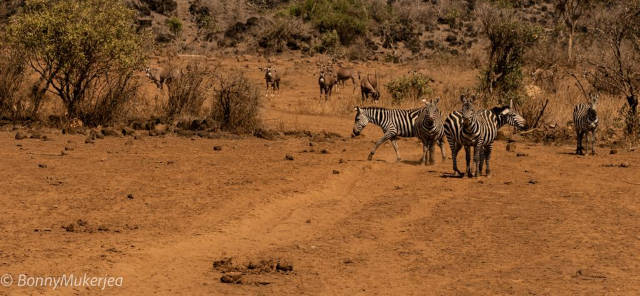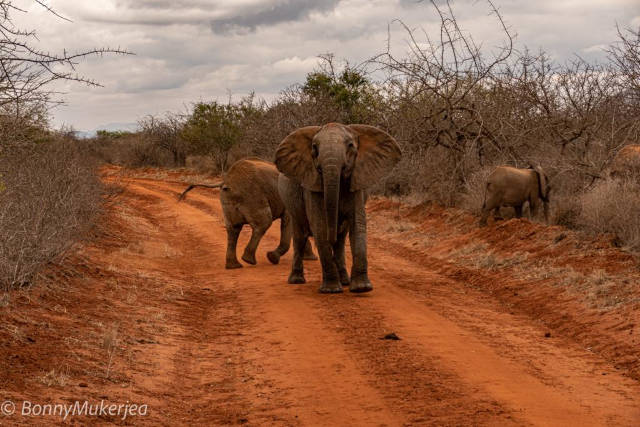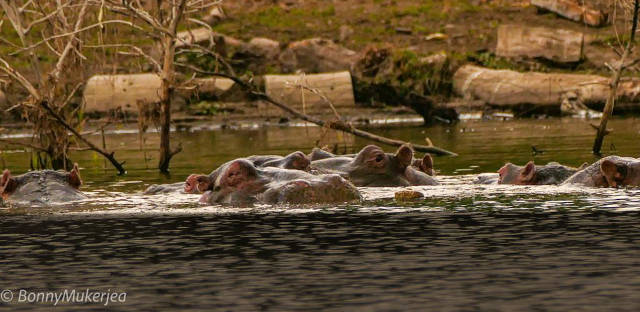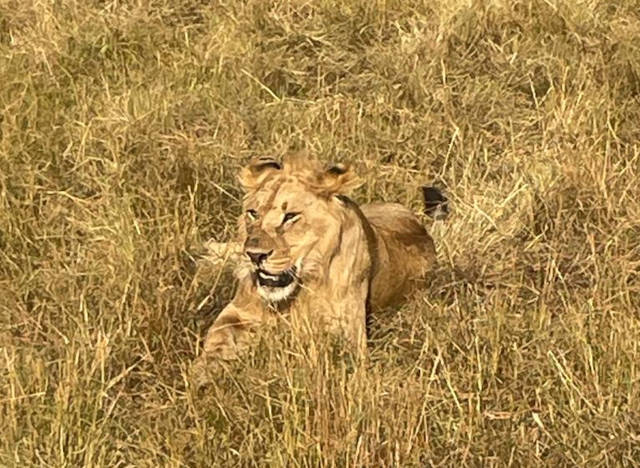I am standing at the edge of an airstrip, somewhere on the Masai Mara reserve in Kenya. Africa stretches out in front of me, an endless expanse of blue skies flecked with wispy clouds, yellow savannah grass, and in the far distance, misty blue hills blending into the horizon. Towards the far right is a shed meant for aircraft, but seldom used. Lions like sheltering under aircraft wings, the shed being an added attraction; shooing them away upends flight schedules. In front, on a landing strip, are parked a few fixed-wing planes with propellers, waiting to ferry tourists, perhaps to Nairobi, or maybe some game reserve. It’s not really a runway, but more a mass of reddish-brown gravel with very little grass. A throng of school kids in blue uniform stare wide-eyed at the planes; they are from a nearby missionary school and have come to see planes take off and land for the first time. Somewhere towards the left, a Land Rover has just been unloaded. Standing next to it are a pair of Masai warriors, tall and red.
Is this the Africa I have always imagined?
There are many Africas. There’s the Africa of the pyramids, there’s the Africa of the world’s largest desert, there’s the Africa of the excruciatingly tough road rally, and there’s the Africa where Mohandas Karamchand became Gandhi. In fact, my wife and I were over there some years back, doing the usual stuff: Lions at Kruger, seals off Cape Town, vineyards along the wine route and even a game of IPL at Johannesburg. Yet, despite it being the only one of the 54 countries to carry the name of the continent (South Africa), it didn’t seem like, well, Africa! It was more Europe, with some game reserves thrown in.
But this—this was different. This is how Africa was always meant to be. I can picture the daily battle of primitive man with giant beasts on the grasslands. Indeed, The Great Rift Valley, considered to be the home of the earliest man, runs through Kenya. This is the Africa that inspired Ernest Hemmingway to write some of his finest stories like The Snows of Kilimanjaro or the Green Hills of Africa. This is the Africa of Karen Blixen’s autobiography Out of Africa, later made into an eponymous, multi-Oscar-winning film. For a boy growing up in Calcutta of the 1970s and 1980s, this is the Africa of Elsa, the lioness. A few days earlier we visited Joy and George Adamson’s house on the edge of Lake Naivasha, triggering an avalanche of schoolboy memories. This is also the Africa of British oppression during the Mau Mau uprising, dispossession and plenty other events that have Sub-Continental parallels.
My airstrip reverie is on the penultimate day of our Masai Mara safari. The next day we return to Nairobi and then, back to the different parts of the world we have come from. There are 35 of us—school mates, wives, children. And Ammi, our solitary adult supervisor, a friend’s mother. At 80, Ammi is the oldest, while my daughter, just shy of 10, is the youngest.
A sputtering start
It all began back in 2020, when a friend from school who organises safaris at various African countries like Kenya, Tanzania, and Botswana (Vikram Dayal; www.incredibleafricasafaris.com) suggested (on the WhatsApp alumni group, where else?!) that we see the migration in Kenya the following year.
Between July and September every year, over a million wildebeest, tens of thousands of zebras, gazelles, etc move in an unending column across the vast plains of east Africa, from Serengeti (in Tanzania) to Masai Mara (in Kenya) in search of new grazing grounds. Spread over both nations, this is basically one enormous piece of land, some 16,000 square kilometres in all. The movement is an ancient ritual, and it triggers another: in the footsteps of these plant eaters come the predators. This symphony of life and death is one of nature’s greatest spectacles, a must see.
Then came Covid and all plans vanished.
We picked up the threads again in early 2021, with every intention of going to Kenya the following year. Given that most safaris to Kenya happen during the migration, they need to be planned at least a year in advance. If you keep it too late, you may not get the best hotels, the safari vehicles may all be booked and even entry to the game parks may be difficult given that authorities control the number of vehicles allowed in.
We paid a token advance so that tentative reservations could be made at the hotels. More important, we formed a WhatsApp group. In the spirit of full disclosure know that wives weren’t a part of the group. The trip was far from being fleshed out and in the spirit of chivalry, we didn’t want to burden them with tiresome planning. We are also from an all-boys school, and it would take many Zoom calls amongst us to figure out when exactly to allow the ladies in. This trip, remember, was being planned by a group of 50-something-year- old men with brains of 14-year-olds.
Again Covid, the second wave, and once again it seemed like the safari wasn’t meant to be. Nonetheless, Vikram kept our hopes alive, over the WhatsApp group, mainly through a steady chatter of Kenyan flora and fauna, what to expect of a safari or for that matter, how to tell the difference between a male and female African elephant. (Foreheads of females have a steeper angle!)
By early this year, once it became clear that Covid was receding, we got back to planning the trip. The itinerary was decided (four parks from the third week of July to early August), we made our payments, and most crucially, the wives became part of the WhatsApp group finally. From now on, we were on our best behaviour (no more Ajit ‘loin’ jokes!)
They stamped their authority over us and took charge of all the planning. We meekly surrendered. Then one day came the bombshell. Each person could carry only 15 kg of luggage, including cameras, lenses, laptops, etc.
Unlike at Indian wildlife parks, where the hotels are beyond the buffer zones, in Kenya, they are deep inside. Most of the better resorts have an adjoining airstrip. These serve as a vital link with the outside world, not just to move men and material, but also to move the sick in case of a medical emergency. Our insurance, for example, covered the cost of air ambulance. And the planes that fly around like an airborne share-taxi service (pick a bunch at some park, drop another somewhere else), usually have a limit of 15 kg, that too ideally in soft-top bags.
While the globe-trotters threw airs (‘I can pack a year’s worth of clothing,’ kind of nonchalance) the rest of us were worried. Videos on how to pack were shared (roll up the clothes, carry quick dry garments, etc) along with helpful insights (‘Did Tarzan bathe every day?’).
WhatsApp groups! What shall we do without them? (Later we realised that the powers that be had formed their own WhatsApp group for more ‘practical’, ‘result-oriented’ and ‘meaningful’ conversation.)
Finally, after overcoming all challenges, real or imagined, the gang converged at Nairobi, with the pioneering spirit of yore. When Guran gave Phantom the news in the Skull Cave, he was unperturbed. He reportedly said that this was a bunch of overgrown and overweight school boys, whose wives and children would happily dump them at the first available opportunity. Phantom’s insight, as the old jungle saying goes, is unmatched.
The safari

[The savannah and in the far distance, misty blue hills blending into the horizon]
Our first stop was Tsavo, roughly 260 kilometres from Nairobi. It is the setting for one of the world’s greatest shikar stories, on par with Jim Corbett’s Man-Eaters of Kumaon. Back in the late 1890s, while Imperial Britain was laying a railway bridge in the area, a pair of man-eating lions attacked the workers, many of whom happened to be from India. Over a hundred men were killed before the engineer in charge, Lt. Col. John Henry Patterson killed the pair. He wrote The Man Eaters of Tsavo, recounting his hair-raising tale. The stuffed lions are on display at Chicago’s Field Museum (they look decidedly benign), while the railway line is still active. I saw it.
Tsavo was special, perhaps because we saw the first glimpse of what Africa had on offer. The spectacle came up so unexpectedly that we gasped. After check-in at the hotel, we were walking towards what we thought was a long veranda adjoining the dining area. And that’s when we saw it—a herd of 20 plus elephants jostling about in the water hole in front. They were so close that we, man and elephant, shared the same space, breathing the same air. It just wasn’t elephants. There were buffalo, giraffe, zebra, and gazelle.

[At Tsavo]
You could see the waterhole from the rooms too. But there was something special about being in communion with nature with a group of intimate friends. That veranda became our watering hole, where we would congregate first thing in the morning and through late into the night after game drives. There we would be sitting, with a drink in our hands, chatting away, when someone would suddenly say, ‘Just look at that’. It could be a herd of African buffalo moving in after the elephants left (I noticed a pattern in which the animals came and went), or a pair of hyenas shuffle up for a quick lick of water. Silence would descend over the group and magic would unfold in front of us, all over again. We weren’t in communion with just the animals, but with each other as well.
From Tsavo we went to Amboseli, then to Lake Naivasha and finally to Masai Mara. We saw leopard, lion, giraffe, rhino, hippo, cheetah, crocodile, what have you. We would be woken up by the roar of the lions or the frenzied laughter of the hyena.

[An elephant charges]
At Amboseli, a bull elephant came dangerously close to the hotel lawn before veering off. At Lake Naivasha hotel staff walked us to our rooms at night because hippos keep showing up near the rooms. At Masai Mara we saw the wildebeest jump into river on one side, and clamber up on the other, having beat the crocodiles. We saw a cheetah with four cubs walking leisurely in the grass. We also had a picnic on the savannah under an acacia tree, surprisingly unconcerned about the animals all around us. It was National Geographic over and over and over again.

[Hippos at Naivasha]
But what made each sighting precious was the shared sense of awe. Humans are master communicators; that light squeeze of the hand, that sentence delivered in hushed tones, that collective whipping out the smartphones to take a picture, or that very apt line ‘see my left-fore finger, that’s where the leopard is’. And then, together, we would enjoy the moment.

[At Masai Mara]
Safaris are also endless vigils, waiting for the action to happen. At Amboseli one evening, with Kilimanjaro in the background, we saw a lion staring at a wildebeest. The wildebeest was transfixed: so was the lion. All of us were fervently waiting for lion to suddenly get up and chase down its prey. Unfortunately, the lion didn’t oblige us, and as it was getting very dark, we left, with the lion and wildebeest still staring each other down.
Such a long wait with strangers would be unbearable. But with friends it had a pleasant quality. Swap stories, invoke some forgotten memory, or at worse, crack a joke. In the evenings, we would sing songs; a local song that caught on was Kenyan superhit, Jambo Bwana. Or, look at the pictures each one had taken and relive the day. A mock-charge by an elephant at Tsavo became a matter of much mirth when recounted. While it was unnerving when it happened, the retelling centred around who held his nerve and who…well!
One evening my little daughter sauntered up to the bar, and asked for a virgin colada. One of the older didis in the group had taught her the joys of non-alcoholic cocktails. Another day, a friend and son cooked meat for us. He had carried the spices all the way from Seattle.
Soon it was all over. But not before everyone realised that while the animals and the sights were magnificent, what truly elevated the trip was the camaraderie and kinship, because every moment was savoured, not alone, but jointly.
Last month, the title of our WhatsApp group was changed from Kenya2022 to Tanzania2024.
But that story is yet to be written.
Bonny Mukerjea is Chief Executive Digital Business RPSG Group. Prior to that was President, ABP Digital.

